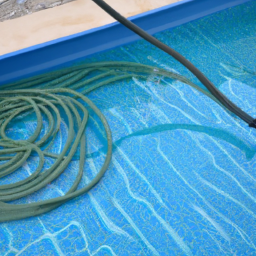Draining an Inground Pool How-To with a Garden Hose
Table of Contents []
How To Drain Inground Pool With Garden Hose
Introduction
Drain inground pools with a garden hose is a process that may be labor-intensive but is definitely achievable. Whether you're draining the pool due to maintenance needs or for the winter season, it's important to understand the best ways of draining inground pools with a garden hose. In this article, we look at the 8-12 topics related to draining inground pools with a garden hose, from understanding the process to necessary tools. Let's dive in.
Safety First
The first topic we cover is safety. It's important to remember that draining an inground pool takes time, and can require continuous monitoring. It's not safe to empty a pool in a single day. In addition, you'll have to use ladders and other tools to reach low points in the pool, and stepping in and out of the pool to ensure that the water is draining properly. Therefore, it's important to take safety precautions such as keeping the area clean and free of trip hazards, wearing non-slip shoes, wearing appropriate clothing, and not reaching for anything above the shoulders while in the pool.
Drainage Equipment
The next topic we look at is the type of drainage equipment needed for draining an inground pool with a garden hose. The most important tool is a sump pump. This will help you move water out the pool's skimmer hole. Other than the sump pump, you'll need drainage hoses, water pumps, and maybe even a vacuum cleaner. It's best to get advice from a pool professional or a drainage professional regarding the best type of equipment for your particular pool.
Preparations Before Drainage
The third topic is preparations before drainage. It's essential to ensure that the pool is clean before draining it. This involves checking the water level, cleaning out the trash, removing any debris or algae, and checking for leaks. In addition, it's important to turn off any pumps and power supplies that are connected to the pool to prevent electrocution.
Drainage Process
The fourth topic is the drainage process. This involves measuring the depth of the pool and calculating the amount of water you need to drain out. Once you have the amount, you'll need to set up and connect the drainage equipment. This usually involves attaching the sump pump to the skimmer and the pool floor, as well as connecting the hoses and pumps. The last step is to start the drainage process. You'll need to monitor the process to ensure that the water is draining properly and that the pool is not overflowing.
Submerged Drainage Hoses
The fifth topic we look at is submerged drainage hoses. It's important to ensure that the hose is positioned properly before you start the drainage process. Otherwise, it can cause the water level to drop too quickly, resulting in overflow and potential damage to the pool. When setting up the hose, consider factors such as the length and diameter. The longer the hose, the more water you can pump out at once, but also be aware that the diameter of the hose can restrict the flow of the water.
Controlling the Flow
The sixth topic is controlling the flow. It's important to remember that draining inground pools with a garden hose requires patience. You'll need to measure and monitor the flow of the water to ensure that it's draining properly. You can always adjust the flow by changing the amount of water you're pumping out at once. If the flow is too fast or too slow, you may need to adjust the length or diameter of the hose or pump out smaller amounts of water at a time.
Leaky Drainage Pipes
The seventh topic is dealing with leaky drainage pipes. Leaky drainage pipes can cause water to back up and spill out of the pool, resulting in potential damage and possible electrocution. To prevent this, it's important to repair any leaky pipes before you start the drainage process. You can also take steps such as draining the water out slowly to reduce the pressure on the pipes and minimizing the amount of debris that can clog the pipes.
Pool Refill Process
The eighth topic is the pool refill process. After you've drained the pool, you'll need to refill it with fresh water. This can be a lengthy process so it's important to take your time to ensure that the water is properly balanced. This includes checking the pH balance, chlorine levels, and other water chemistry parameters. Once the water is ready, you'll need to power up the pool pumps to circulate the water and start the filtration system.
Checklists and Instructions
The ninth topic is checklists and instructions. It's important to create a checklist to ensure that all safety precautions have been taken and all the necessary steps have been completed. It's also important to read and follow the instructions that come with the drainage equipment, such as the sump pump, the hoses, and the water pumps. This will help ensure that the water is draining properly and that all the components are functioning correctly.
Final Thoughts
Draining inground pools with a garden hose is a difficult but achievable task. With the right planning and understanding of the process, you can drain your pool safely and efficiently. Remember to take safety precautions, understand the drainage equipment needed for the process, and read and follow the instructions that come with the equipment. With the right preparation, you can ensure that your pool is drained correctly and ready for the refill process.

Previous Page
Next Page
